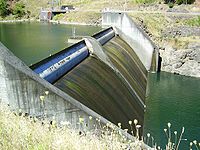
Photo from wikipedia
INTRODUCTION Flow diversion has become increasingly popular for treatment of cerebral aneurysms over the last few years. There has been an increasing number of patients with aneurysms who have failed… Click to show full abstract
INTRODUCTION Flow diversion has become increasingly popular for treatment of cerebral aneurysms over the last few years. There has been an increasing number of patients with aneurysms who have failed flow diversion, with paucity in the literature of salvage treatment for these challenging cases. METHODS We present a multi-center series of 13 aneurysms that failed treatment with flow diversion and were treated subsequently with open surgery. We also present a review of the literature regarding operative management of aneurysms following unsuccessful treatment with flow diversion. RESULTS Twelve patients with 13 aneurysms were included in this study. All patients had surgery after flow diversion for persistent aneurysm filling, mass effect, or aneurysm rupture. Patients were treated with aneurysm clipping and parent vessel reconstruction, decompression of the aneurysm mass, occlusion of proximal flow to the aneurysm or aneurysm trapping with or without extracranial-intracranial (EC-IC) artery bypass. CONCLUSIONS Aneurysms that fail flow diversion present a variety of unique and challenging management situations that will likely be encountered with increased frequency given the popularity of flow diversion. Microsurgical bailout options require an individualized care that is tailored to the underlying pathology, patient characteristics, and surgical expertise.
Journal Title: World neurosurgery
Year Published: 2019
Link to full text (if available)
Share on Social Media: Sign Up to like & get
recommendations!